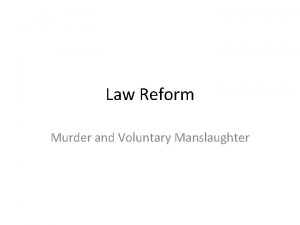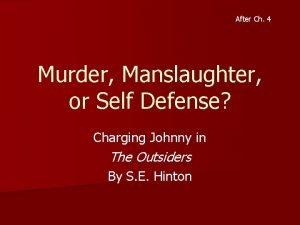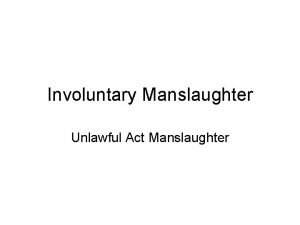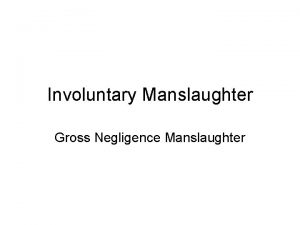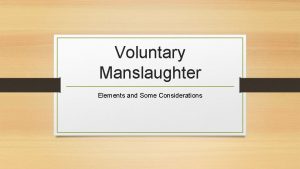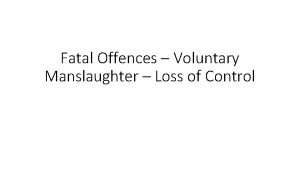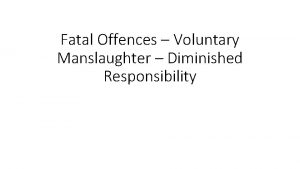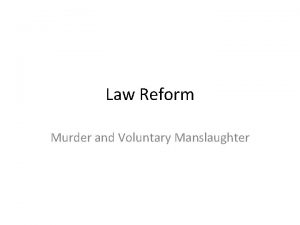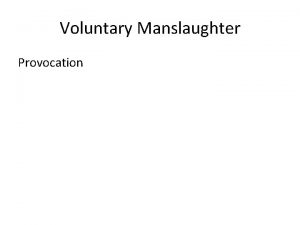TOPICS Murder Voluntary Manslaughter Loss Of Control Diminished














- Slides: 14

TOPICS • Murder • Voluntary Manslaughter – Loss Of Control + Diminished Responsibility • Murder + Voluntary Manslaughter Reforms • Involuntary Manslaughter – Gross Negligence + Unlawful Act • Assault + Battery + Actual Bodily Harm + Grievous Bodily Harm With Intent • Offences Against The Person Reforms • Insanity + Automatism + Intoxication + Self Defence + Consent • General Defences Reforms

MURDER - ANSWER PLAN • 1. DEFINITION OF MURDER. • 2. ACTUS REUS – QUICK PARTS. • 3. ACTUS REUS – CAUSATION. • 4. TAKE YOUR VICTIM AS YOU FIND HIM. • 5. MENS REA – DIRECT OR INTENTION TO CAUSE GBH (IMPLIED) OR OBLIQUE (INDIRECT) INTENTION. • 6. TRANSFERRED MALICE • 7. CONCIDENCE OF ACTUS REUS AND MENS REA • 8. VOLUNTARY MANSLAUGHTER - LOSS OF CONTROL. • 9. VOLUNTARY MANSLAUGHTER - DIMINISHED RESPONSIBILITY. • 10. GENERAL DEFENCES. • NB. YOU NEED ONLY APPLY THOSE STEPS THAT ARE RELEVANT.

VOLUNTARY MANSLAUGHTER - LOSS OF CONTROL • 1. Section 54 of the Coroners and Justice Act 2009 • • 2. Loss of Self Control – doesn’t have to be sudden but still remained out of control, Ibrams and Gregory, Baillie, Ahluwalia, Thornton. • • 3. Qualifying Trigger i. Fear of serious violence from V. Subjective + no need for actual violence. Fear must be genuine. • • ii. Things said or done which let to circumstances were of a grave character + D had a justifiable sense of being seriously wronged. • • 4. Restrictions – Incitement; Sexual Infidelity (Clinton, Davis & Hatter); Revenge; • 5. Objective Test – D’s own sex and age with a normal degree of tolerance and self-restraint would have reacted in a similar way. EXCLUDE factors affecting tolerance and self-restraint e. g. bad-temper and violence (Mohammed), • • VOLUNTARY MANSLAUGHTER DIMINISHED RESPONSIBILITY 1. Section 2 Homicide Act - - Section 52 Coroners and Justice Act 2009 on a balance of probabilities. 2. Abnormality of Mental Functioning – Byrne – “state of mind so different…that a reasonable person would term it abnormal. 3. Arising From a Recognised Medical Condition. 4. Substantial Impairment of Mental Responsibility…one of the following: i. understand nature of conduct or ii. form a rational judgment or iii. exercise self-control Egan – more than trivial degree of impairment but less than total impairment. 5. Provides Explanation for D’s Acts. 6. Intoxication – exclude, Dietschmann unless suffering from alcoholism – Wood.

GROSS NEGLIGENCE MANSLAUGHTER • 1. DEFINITION - when V dies as a result of the negligence of D, + degree of negligence by D is sufficiently serious as to make D criminally liable for the death. • 2. DUTY OF CARE (CHOOSE AT LEAST ONE) - Adomako - ordinary principles of negligence in civil law should apply when ascertaining whether a duty of care existed, and if so, whether it was breached. • Defendant Takes On A Voluntary Duty -Stone and Dobinson + Gibbins and Proctor. • Where A Person’s Contract Requires Him To Act - Litchfield + Pitwood + Singh. • Where D And V Are Complicit In A Crime – Wacker + Willoughby. • Where A Person's Public Position Requires Him To Act – Dytham. • Where D Creates A Dangerous Situation and Fails to Minimise the Risk – Miller. • Where D Creates A State Of Affairs Which He Knows Or Ought Reasonably To Know Has Become Life Threatening – Evans. • Where D Has A Statutory Duty To Act - Children and Young Persons Act 1933 – children must wear a seatbelt. • 3. BREACH OF DUTY - Misra and Srivastava. • 4. CAUSATION BY AN ACT OF THE DEFENDANT+ BREAK IN CHAIN OF CAUSATION HERE + THIN SKULL RULE – normal rules i. e. factual and legal causation, intervening acts, Blaue, etc. OR • 4. CAUSATION CAUSED BY AN OMISSION - No definitive test…it is likely that D will have caused a consequence by an omission only when, had he fulfilled his duty, V would not have died or, at any rate, it is highly probable that V would not have died. Again, consider intervening acts, Blaue, etc. • 5. GROSS NEGLIGENCE • Adomako - Jury will have to consider whether the extent to which the defendant's conduct departed from the proper standard of care incumbent upon him, involving as it must have done a risk of death to the patient, was such that it should be judged as criminal. • Bateman - Degree of negligence must be far greater than in a civil case. Negligence has to be 'gross' and go 'beyond a mere matter of compensation between subjects‘. • Andrews - simple lack of care which would constitute civil liability is not enough…a very high degree of negligence is required to be proved. • 6. RISK OF DEATH • Bateman – test is was there a 'disregard for the life and safety of others. ‘ Stone and Dobinson – test is whether or not there was a risk to the 'health and welfare' of the victim. • 7. MENS REA – Was D reckless as to his actions towards V.

UNLAWFUL ACT MANSLAUGHTER • 1. DEFINITION - when D causes V’s death whilst carrying out a criminal act that is deemed to be dangerous. • 2. THE UNLAWFUL ACT - This must be a criminal offence, normally some kind of physical assault, e. g. assault, battery, ABH and GBH. NOT GBH WITH INTENT! • 3. DANGEROUS ACT - Edmund Davis LJ in Church: The unlawful act must be such as all sober and reasonable people would inevitably recognise…the risk of some physical harm resulting there from, albeit not serious harm. • Therefore, It need not be the accused who necessarily foresaw physical harm, but any 'sober and reasonable' person and the risk may be only 'some physical harm', not necessarily serious harm. • The harm need not be aimed at the victim - Mitchell - it was enough that the initial assault was unlawful and dangerous. • The harm intended/foreseen must be actual physical harm - Dawson. • If obvious someone is frail and vulnerable, the 'reasonable person' would realise that harm could follow from the victim's condition - Watson. • Dangerous act maybe aimed at property - Goodfellow – D’s conviction upheld as he had intentionally committed an unlawful act (arson), which any reasonable person might foresee would cause physical harm. • 4. SUBSTANTIAL CAUSE OF DEATH - same general principles, such as the chain of causation and the thin skull rule, apply to manslaughter as to murder. • Corion-Auguiste – D’s act was the direct and substantial cause of the victim's death. • Kennedy - V's voluntary act in injecting himself had broken the chain of causation. • Shohid - The unlawful and dangerous act need not be the sole cause of death, so long as it was not trivial. • Carey - original attack was not held to be serious enough to be the cause of death. The only dangerous act directed at her was a single punch, which was not the cause of her death. • Lewis (V dies after running into road after being chased by D) - it was decided that the assault was a continuing act and that it was the cause of death, as the victim’s attempted escape in response to the assault was foreseeable • Attorney-General's Reference (No. 4 of 1980) - If more than one unlawful act and cannot be proved which particular act caused the death, it is sufficient to show that any one of them could have been. • 5. MENS REA - sufficient that D had the mens rea to commit the unlawful act only.

INSANITY • 1. GENERAL – only relevant at the time the offence was committed. D must prove that, on the balance of probabilities, he was insane at the time of the offence. Law comes from the case of M'Naghten. • 2. DEFECT OF REASON - an inability by the defendant to use powers of reason, rather than his failing to use his powers of reason – Clarke. • 3. CAUSED BY DISEASE OF THE MIND - legal term not a medical term. Must be a physical disease, not one brought about by external factors such as drugs. Can be permanent state or temporary state. • Kemp - D suffered from arteriosclerosis which affected the flow of blood to his brain. Disease of the mind could be Devlin J stated: 'In my judgment the condition of the brain is irrelevant and so is the question whether the condition of the mind is curable or incurable, transitory or permanent. ’ • Bratty - any mental disorder which was demonstrated by violence that was prone to occur was a disease of the mind. • Sullivan D suffered from epilepsy. It would not be a defence of automatism as that required an external factor. • In Burgess - judge said appropriate defence was insanity because he was sleepwalking which was caused by an internal factor and can be classed as a disease of the mind. • 4. SO THAT D DOES NOT KNOW THE NATURE AND QUALITY OF HIS ACT OR AS NOT TO KNOW THAT WHAT HE WAS DOING WAS WRONG • This means that the defendant proves any of the following: • That he did not know what he was doing. • That he did not appreciate the consequences of his act. • That he did not appreciate the circumstances in which he was acting. • Windle –D pleaded his own insanity, but had originally given himself up to the police saying, 'I suppose I'll hang for this!' As this showed he knew the nature and quality of his act and that what he was doing was wrong, found guilty.

AUTOMATISM • 1. AN INVOLUNTARY ACT - D's act must be involuntary in that his mind is not controlling his limbs in a purposeful manner. Has to be a total lack of awareness, not partly automatic. Attorney-General's Reference (No. 2 of 1992). • 2. THE EXTERNAL FACTOR - automatism has been caused by an external factor such rather than an internal factor. • Quick - D took insulin but had more insulin in the bloodstream than the amount of sugar. As D's condition arose as a consequence of an external factor (the insulin) he could rely on a defence of automatism. • Hennessey - D had not taken his insulin in this case. Court decided that the defence of automatism was not available to him as the diabetes was an internal factor. The only possible defence for a jury to consider was insanity. • Hardie - D took some valium tablets. conviction quashed as D had taken the drug because he thought it would calm him down. • 3. BASIC v SPECIFIC INTENT CRIMES • Specific intent crimes - self-induced automatism can be a defence as D lacks the mens rea as he has been reckless. • Basic intent crimes - no automatism can apply if D has been reckless e. g. forgotten to take medication. D will have to prove that he did not know that his actions were likely to lead to a self-induced automatic state, i. e. he was not reckless and the defence will apply, see Hardie.

INTOXICATION • 1. GENERAL - can be either voluntary or involuntary. If voluntary, D will not be excused from his/her actions. Can be used to show that D could not form the necessary mens rea for offence. • 2. VOLUNTARY v INVOLUNTARY INTOXICATION - Voluntary - where D takes the drink or drugs of his own free will. Involuntary - where D does not know he was taking alcohol or an intoxicating drug – there will only be a defence if the mens rea for crime not formed. Note in Kingston - involuntary intoxication was not a defence to a charge if it was proved that D had the necessary intent when offence was committed, even though D was not to blame for the intoxication. Where D does not realise the strength of the alcohol or drug he has taken, it does not make the intoxication involuntary, Allen. • Where D takes a non-dangerous drug, the taking may be treated as involuntary if he does so non-recklessly, Hardie. Where drug is dangerous, there may be recklessness in self-administering it which would be the case when the drug was well known for causing the effects. • 3. BASIC v SPECIFIC INTENT CRIMES - intoxication is a defence to crimes of specific intent, see Lipman and not those of basic intent, see Majewski. • If mens rea formed before the intoxication, as in 'Dutch Courage', no defence of intoxication available, Attorney- General for Northern Ireland v Gallagher.

BASIC v SPECIFIC INTENT CRIMES BASIC INTENT CRIMES SPECIFIC INTENT CRIMES Offences Against the Person Act 1861 – Section 47 Person Act 1861 – Section 18 Offences Against the Murder Person Act 1861 – Section 20 Assault Battery Involuntary Manslaughter

CONSENT • 1. WHAT ACTIVITIES THAT MIGHT BE AN OFFENCE CAN A PERSON CONSENT TO? - allowed as a defence to assault and battery, but not to Sections 47, 20 and 18 as it is not in the public interest for people to harm each other for no good reason. • Normal Sports Activities - when incident goes beyond rules and regulations of the sport, potential for criminal liability. Barnes criminal proceedings should only take place where conduct of D was sufficiently serious. Consider the following: • The type of sport. • The level at which it was played. • The nature of the act. • The degree of force used. • The extent of risk of injury • The state of mind of the person causing the injury • Horseplay and Sexual Activities - Brown - as a matter of policy the courts have decided that the criminal law does not concern itself with these activities, provided that they do not go too far. • Jones - D’s were entitled to be acquitted if the jury decided that they were indulging in 'rough' and undisciplined sport or play, not intending to cause harm, and genuinely believing that the injuries which occurred in the course of the horseplay occurred with the victim's consent. • Brown - V and D involved in consensual sado-masochistic homosexual activities bur still found guilty i. e. it is not in the public interest that people should cause each other actual bodily harm for no good reason. • Dica - someone who is not told that their partner is HIV positive cannot consent to the risk of infection as a result of unprotected sex. • 2. IS THE CONSENT GENUINE? - if V appears to consent does not mean that it is genuine. If V is a child or is mentally retarded, then the consent may not be valid. Question is did V have sufficient understanding and intelligence to give consent? Burrell v Harmer - defence of consent was not allowed, as court felt that the boys were unable to understand the pain involved whilst recognising what a tattoo was. • Where consent obtained by fraud, it will not be valid. Tabassum – no consent available because V, who had consented to being touched purely for medical purposes, had not consented for any other purpose, contrast Richardson where consent to dental treatment was accepted as a defence even though the patients did not know D had been disqualified from practice.

SELF DEFENCE + PREVENTION OF CRIME • 1. INTRODUCTION - CRIMINAL LAW ACT 1967, SECTION 3 • A person may use such force as is reasonable in the circumstances in the prevention of crime, or in effecting or assisting in the lawful arrest of offenders or suspected offenders or of persons unlawfully at large. • 2. THE NECESSITY OF FORCE - use of force is not justified if it is not necessary. It will be necessary if it is seen to be so in the circumstances which exist or which the defendant genuinely believed existed, Gladstone Williams. • Defence comes into operation even if the attack has not yet taken place providing it is imminent. D does not have to wait for an attack to start but can get in the first blow. D does not have a duty to retreat as far as possible before using force, Bird. • 3. THE REASONABLENESS OF FORCE - jury have the task of deciding whether, in all the circumstances, the defendant used reasonable force. Palmer - it will be recognised that a person defending himself cannot weigh to a nicety the exact measure of his necessary defensive action. • Clegg –held that under the circumstances, neither D nor anyone else was any longer in danger, therefore, D’s plea for self-defence failed, see also Martin (Anthony Edward). • Section 76(7) Criminal Justice and Immigration Act 2008 – reasonableness of force now contained in a statue. • (a) a person acting for a legitimate purpose may not be able to weigh to a nicety the exact measure of an necessary action; and • (b) evidence of a person’s having only done what he person honestly and instinctively thought was necessary for a legitimate purpose constitutes strong evidence that only reasonable action was taken by that person for that purpose.

MURDER + VOLUNTARY MANSLAUGHTER ESSAY VOLUNTARY MANSLAUGHTER MURDER • 1. OBLIQUE INTENTION – problems with Maloney , Hancock, Nedrick, Woolin, Matthews + Alleyne. • 2. INTENTION TO CAUSE GBH – Vickers • 3. MANDOTORY LIFE SENTENCE – no latitude to vary sentence. • 4. REFORM – make sentence discretionary instead of mandatory. Reduce levels of other killings. Have different degrees of murder e. g. in USA. • LOSS OF CONTROL • 1. DEFINITION – Section 54 Coroners and Justice Act 2009 no clear definition, addressed in Jewell and Smith and Hogan. • 2. FEAR OF SERIOUS VIOLENCE - still necessary to lose control based on fear, Law Commission recommended acting out of fear of serious violence be sufficient without need to prove loss of control. • 3. THINGS SAID OR DONE WHICH CAUSED THE DEFENDANT TO HAVE A JUSTIFIABLE SENSE OF BEING WRONGED - sexual infidelity disregarded, however Clinton dilutes impact of provision, therefore, should never have been excluded in the first place. Law Commission in New Zealand has now abolished provocation. • DIMINISHED RESPONSIBILITY • 1. RECOGNISED MEDICAL CONDITION – sometimes D will react to a very stressful situation, this would not protect him. • 2. DIMINISHED RESPONSIBILITY v INSANITY – too many similarities between the two. IF P argues insanity instead, D could be committed to a mental institution. • REFORMS • 1. IMMATURITY OF AGE FOR BOTH ADULTS AND CHILDREN – rejected by the Government for children. • 2. RECLASSIFICATION – Voluntary Manslaughter changed to Second Degree Murder. • 3. LAW COMMISSION PROPOSALS – include a summary.

OFFENCES AGAINST THE PERSON ESSAY • 1. VICTORIAN LEGISLATION - no uniformity of language used between sections and no coherent hierarchy in respect of seriousness of offences. • 2. NO LOGICAL SENTENCING STRUCTURE – Section 47 when compared to assault and battery have different sentences but the same mens rea. Section 20 more serious than Section 47 but carries the same sentence. Jump to life imprisonment for Section 18. • 3. DEVELOPMENT OF LAW – through case law rather than statute. Why? Dica and Konzani re sexually transmitted diseases, Chan Fook and Miller re actual bodily harm. • 4. LANGUAGE – statute does not deal with new types of injuries e. g. psychiatric illnesses or sexually transmitted diseases. • 5. MENS REAS ISSUES – Section 47 only requires mens rea for an assault or battery. Section 20 requires only an intention or recklessness as to some harm. • 6. PROBLEMS WITH INFORMED CONSENT – see cases of Dica, Tabassum and Richardson. • 7. REFORMS - Statutory definitions for assault and battery; Section 47 replaced by offence of intentionally or recklessly causing injury to V with a max prison sentence of five years, ‘injury’ defined as ‘physical injury’, includes pain, unconsciousness + impairment of a V’s physical condition, + ‘mental injury, ’ which includes impairment of V’s mental health. Sections 20 and 18 replaced by offences of recklessly causing serious injury to V and intentionally causing a serious injury to V. Max sentences are seven years and life imprisonment respectively. No reference to wounding. Harm intended or foreseen must correspond to offence. • Proposal to create offence of ‘aggravated assault’ - any assault that causes injury, carrying a maximum sentence 12 months’.

GENERAL DEFENCES ESSAY CONSENT • 1. CONSENT + EUTHANASIA – definition of Euthanasia, Ministry of Justice case. Arguments for and against legalising euthanasia. • 2. CONSENT + SEX – Brown (no), Wilson (yes), Emmett (no). • 3. CONSENT + HORSEPLAY – Jones and Another, Aitken. Inconsistencies in the law when compared to Brown and Wilson. • 4. REFORMS - 1995 Law Commission published Consultation Paper - key issue was to what extent D be able to consent to injury being inflicted upon him. Law Commission stated law needed clarification because of conflicting decisions, concluded that Vs consent to personal injury should be valid except where injury is seriously disabling or involves death, and even there should be an exception for legitimate reasons, such as medical treatment. • Proposals appear a satisfactory compromise between need to respect the autonomy of D and V and need to protect the V. Where injury is seriously disabling or worse, appropriate for state to intervene, but not in cases like Brown where no long-term injuries. In Brown D was guilty, but under reform proposals V could consent to such injuries. • • SELF DEFENCE 1. WAS THE FORCE NECESSARY? – defence heavily weighted towards D Gladstone Williams, no duty to retreat, Bird, pre-emptive strike, Beckford. 2. WAS THE FORCE REASONABLE? – Palmer – D cannot weigh to a nicety the exact measure of his necessary defensive action. 3. HIGH PROFILE CASES – Lee Clegg and Tony Martin – D’s characteristics not considered so guilty of murder! All or nothing defence although loss of control has alleviated this problem, see also Munir Hussain, Cairns. 4. CRIMINAL JUSTICE AND IMMIGRATION ACT 2008 – confusion as to what this means? Wording indicates D’s characteristics ought to be considered.
 Voluntary manslaughter
Voluntary manslaughter Example of voluntary manslaughter
Example of voluntary manslaughter Example of direct voluntariness
Example of direct voluntariness Diminished responsibility
Diminished responsibility Diminished protective capacities
Diminished protective capacities Diminished blood supply
Diminished blood supply Lip oedema
Lip oedema Diminished responsibility evaluation
Diminished responsibility evaluation Diminished responsibility in criminal law
Diminished responsibility in criminal law Scrap account
Scrap account Bobath grading of voluntary control
Bobath grading of voluntary control Unlawful act manslaughter definition
Unlawful act manslaughter definition Manslaughter definition in the outsiders
Manslaughter definition in the outsiders Involuntary manslaughter example
Involuntary manslaughter example Gross negligence manslaughter actus reus
Gross negligence manslaughter actus reus

